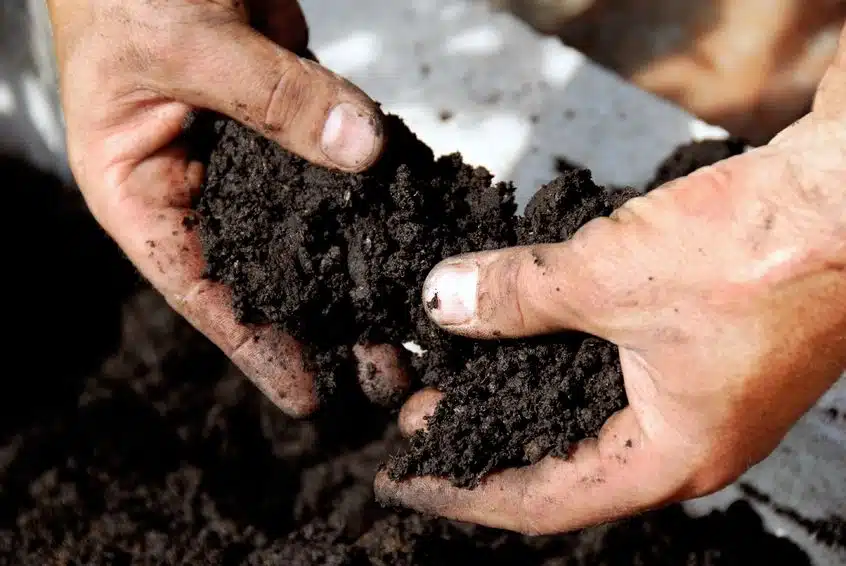humus
/ˈhjuːməs/
noun
- the organic component of soil, formed by the decomposition of leaves and other plant material by soil microorganisms.
The dictionary definition of humus seems to be fairly straightforward. But, in an article in Eco Farming Daily, German-Norwegian explorer of soil life, Herwig Pommeresche, argues that there is more to humus than carbon counting.
Carbon is the basic building block of organic material. Thus, total soil humus content is often expressed in terms of carbon content percentage. However, by referring to the abundance of organic substances present in the soil to understand humus, we are overlooking a key component – its mineral content.
What do we mean by minerals?
It’s important to define that “mineral” content in this instance refers to everything from gravel to rocks, sand, and the very finest mechanically ground particles. We’re not talking about fertilisers or other salt ions!
In M.M. Kononova’s treatise, “The Soil’s Humic Substances – Results and Problems in Humus Research” (1958), it says: “The history of humus research is rich in incorrect approaches to clarifying important questions, which has led to contradictions and confused ideas about the nature of humic substances, their origins, and the role they play in forming the soil and determining its fertility.”
Looking at mineral content is more important than ever before
With the advent of modern agriculture, deforestation and industrialisation, the ratio between the organic and mineral portions of the world’s soil has shifted. To its detriment, the proportion of minerals has increased in cultivated soils.
To understand humus as a whole, we need to understand humusphere formation
In literal, spatial terms, the humusphere is the space between the atmosphere (the gas sphere) and the lithosphere (the rock sphere).This is where the entire metabolism of all dead and living material is carried out in a continuous cycle, a process driven by microorganisms. It is where the movement occurs from the waste material of living material into the Earth, and back into living material.
In his article, Herwig Pommeresche emphasises that the cycle of living material takes place in the topsoil through the mediation of bacteria, not through the conceptual model of mineralisation – which suggests the complete breakdown of all organic material into inorganic base materials.
Evidence he gives for this is that the same species of bacterial symbionts (the lactic acid bacteria) appear in almost all animal and plant organisms around the world. And the more a soil contains, the more fertile it is.
The cycle perpetuates as follows:
- The remnants of biological processes on the surface are first processed by budding fungi species (yeasts and moulds)
- They are then passed along to the bacterial symbionts in the soil
- These symbionts can be directly consumed and digested as food by plant root hairs via endocytosis
- They leave all kinds of organic material behind after they die
- These particles, along with the bacteria themselves are a prerequisite for the formation of high-quality soil.
Pommeresche says: “In contrast to the views of agrochemists, it is this alone that deserves the name “humus” in the biological sense: a conglomeration of organic and inorganic material. And this means that it is completely impossible to describe humus as a dead, chemical substance!
Humus formation is a sort of “organic predigestion” for plants; and at the same time, humic soil serves as a pantry of living nutrients during the growing season, when plants can grow only if supplied with sufficient warmth, water, and sunlight.”
Why is humus so important?
To put the importance of soil substances in perspective, a single rye plant has the equivalent surface area of an entire garden in terms of root surface area. With all this direct contact with the soil, the composition of this soil is crucially important.
Austrian writer and scientist Annie Francé-Harrar wrote the following about an ideal composition for healthy soil and optimal plant growth.
- 65% organic material
- 20% edaphic organisms
- 15% mineral substances.
She also, however, acknowledged (even back in the 1950s) how this was rarely the case:
“This kind of abundance of organic material exists hardly anywhere on the planet any more, the highest concentrations being in untrodden corners of tropical jungles, but never in our growing soil. But it is possible to restore the organic-inorganic balance in growing soil within a practical timespan through systematically employed humus management.”
Getting the balance right
Humic acids are an important ingredient in developing and maintaining a healthy soil. Soluble humate granules are excellent in improving soil structure and increasing nutrient uptake. With a minimum of 70% potassium humate, they act as an additive to granular fertilisers such as urea and promote the creation of beneficial fungi, which create a crumb structure that optimises soil structure for better water and oxygen uptake and improved root penetration. Contact our distributors Real IPM via our map for more information.
The team at Zylem are on hand to explain applications and precautions associated with humic acid. Contact us on 033 347 2893 or send your enquiry to admin@zylemsa.co.za.

About the Author: Alex Platt
Alex is Business Development Manager at Zylem. He’s inspired by the potential of regenerative farming and takes a special interest in the technology and products that are moving agriculture in a more sustainable direction.

